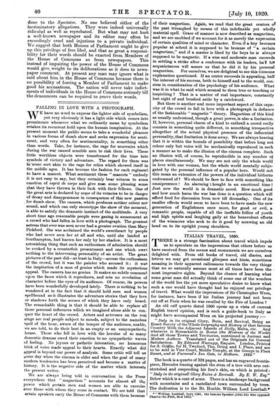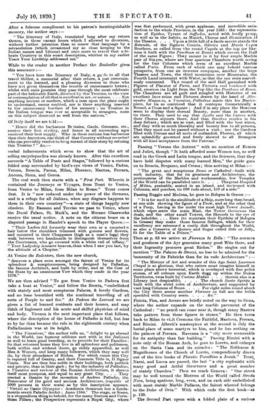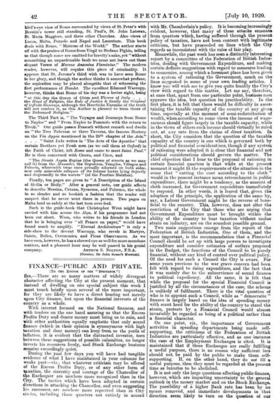ITALIAN TRAVEL, 1660.
THERE is a strange fascination about travel which impels us to speculate on the impressions that others before us
have received from the scenes and monuments we are ourselves delighted with. From old books of travel, old diaries, and letters we may get occasional glimpses and hints, sometimes amazing in their apparent callousness towards the very things that we so naturally assume must at all times have been the most impressive sights. Beyond the chance of learning what some great man did actually think of some one of the wonders of the world lies the yet more speculative desire to know what such a one would have thought had he enjoyed our privilege of travel. What would the impressions of Sir Christopher Wren, for instance, have been if his Italian journey had not been cut off at Paris when he was recalled by the Fire of London ?
An old calf quarto dated 1660 opens up a vista of current English travel opinion, and is such a guide-book to Italy as might have accompanied Wren on his projected journey :—
" Italy in its original Glory, Ruin, and Revival, Being an Exact Survey of the Whole Geography and History of that famous Country With the Adjacent Islands of Sicily, Malta, etc. And whatever is Remarkable in Rome (the Mistress of the World) And all those Towns and Territories, mentioned in Antient and Modern Authors. Translated out of the Originals for General Satisfaction. By Edmund Wareupp, Esquire. London, Printed for S. Griffin, for H. Twyford, Tho. Dring and I. place, and are to be sold in Vine Court, Middle Temple, at the George in Fleet Street, and at Furneval's Inn Gate, in Holborn. 1660."
The book is a quarto of 328 pages, and has an engraved frontis- piece, Hercules leaning against the stem of a tree with arm out- stretched and suspending his lion's skin, on which is printed : "Italy in its original? Glory Ruing & Bevivall. By B. W. Esq." Below which is a coat of arms. There is a landscape background with mountains and a castellated town surrounded by trees. The dedication is to the Rt. Honble. William Lord Lenthall.* • "William Lenthalliro 1591, the famous Speaker (1641-53) who opposed Charles the nest, dltd
After a fulsome compliment to his patron's inextinguishable memory, the author says :— "The Itinerary of Italy, translated long after my return thence, in those vacant hours which I allowed to diversion, without farther intention than to renew that language by a retranslation (which occasioned my so close keeping to the Italian names and Idioms) and once more to travel that 031e- brate Countrey in this exact description, whither in my earlier Years Your Lordship addressed me.'
While to the reader in another Preface the Bookseller gives this assurance :— "You have here the Itinerary of Italy, a gu'do to all that travel thither, a memorial after their return, a just entertain- ment to the learned, and a pleasing diversion to those who have not given themselves the trouble of unnecessarie letters ; whilst with easie journies they pass through the most celebrate part of the habitable Earth, directed by this Treatise, to the view or contemplation of all that is excellent in art, or nature. . . . Not anything ancient or modern, which a men upon the place ought to understand, seems omitted, nor is there anything inserted to the unnecessary burthen of his memory : no Treatise in the Italian tongue was ever so acceptable to strangers, none on this subject deserved so well from the natives.'
Of Rely itself we are tcld :— "Hence did the barbarous Br itains, Gauls, Germans, etc., receive their first civility, and hence in all succeeding ages received their best supply. Who in these nations lees barbarous then their Ancestors, ean think of that Country without reverAce? who can peevishly resolve to be ig norant of their story by refusing this Treatise I" &o.— verbal inducements which seem to show that the art of selling encyclopaedies was already known. After this exordium succeeds "A Table of Posts and Stages," followed by a curious folded map surrounded by bird's-eye views of Venice, Padua, Verona, Brescia, Parma, Milan, Florence, Mantua, Ferrara, Ancona, Siena, and Genoa.
The real work then starts with a "First Part. Wherein is contained the Journeys or Vsyages, from Trent to Venice, from Venice to Milan, from Milan to Rome." Trent comes first. It is "now reduced under the power of the Germans, and is a refuge for all Italians, when any disgrace happens to them in their own countrey "—a state of things happily now obsolete. By Bassano and Treviso we pass to Venice, where the Ducal Palace, St. Mark's, and the Murano Glassworks receive the usual notice. A note on the citizens bears on a disputed passage in Hamlet's speech to the Player Queen :—
" Their Ladies did formerly wear their own or a counterfat hair below the shoulders trimmed with gamma and flowers, and mounted in their Chappenes (high as a man's legg) they walk between two handmaids to distinguish themselves from the Courtezans, who go covered with a white veil of tiffany." "Your Ladyship is nearer heaven, than when I saw you last, by the altitude of a Chopine."
At Venice the Bedentore, then the new church, "deserves a place even amongst the fairest of Venice for its splendour & sumptuousness, being designed by Palladius, the famous Architect, and built by order, and at the Cost of the State by an unanimous Vow which they made in the year 1576."
We are then advised "To gee from Venice to Padova first take a boat at Venice," and follow the Brenta, "embellished with stately and most sumptuous Palaces, & lovely Gardens, and no lease beautified with the continual travelling of all sorts of People to and fro." At Padova the Learned we are given a list of learned residents and their houses, and may think of Inglesant and his acute and skilful physician of mind and body. Vicenza is the next important place that follows, where the description of the house of Palladio is full, but less so by far than became the rule in the eighteenth century when Palladianism was at its height.
"The Vicentines," the author tells us, "delight to go abroad in the World, (an humour seldome met with in the Italians) as well to learn good breeding, as to provide for their Families : So that returned home they live in all splendour and politeness, both within and without doors, go richly apparelled, as well Men & Women, and keep many followers, which they may well do, by their abundance of Riches. For which cause this City is reputed full of Gentry, and their Common Title is, Ii Signor Conte. Nor are they less noble in their buildings, both publick and private, than in their garb ; for by the industry of Palladino, a Vicentine and reviver of the Roman Architecture, it shewes itself most pompous, and equal to any great City. . . . They erected a theatre by the invention of Andreo Palladio, the Renovator of the good and ancient Architecture, (capable of 5000 persons in their seats) as by this inscription appears. Virtuti no Genie Glympior : Academia thee.trum hoc a funda- mantis erexit Paladio Archit : Arum 1584."rhe stage, or Scene, is a stupendious thing to behold, for the many Statues and Corin- thian Pillars ; the Prospective represents a Royal City, where was first performed, with great applause, and incredible satis- faction to the whole Province, in the year 1585: the representa- tion of Epidus, Tyrant of Soffales, acted with lordly penal; as well as in the habits, as Musick, Chorus and illumination of the Theatre. . . . Up on a little hill of a facile ascent stands the Rotunda, of the Signora Counts, Oderico and Mario Cepre Brothers, so called from the round Cupola at the top (or like- ness it hath with the Pantheon at Rome) which covens the Hall of the same Figure : They mount to it by four ample Marble pair of Sta yrs, where are four spacious Chambers worth seeing for the fair Columns which seem of an excellent Marble called Peri& From each of which one may behold various prospects, from one an immense carnpagna, another the large Theatre and Town, the third mountains over Mountains, the Fourth Land intermixt with Water, so that the eye rests marvel- ously contented. The round of the said Hall garnished with Figures of Plai star of Paris, and Pictures end bordered with gold, receives its Light from the Top like the Pantheon of Rome. The Chambers are all guilt and mingled with Histories of an excellent Inve ntion and Pictures drawn by the hand of Ales- sandro Maganza, a Vicentine, Palladius made this his Master- piece, for tis so contrived that it conteyns Geometrically a Round, a Cross and a Square : And if in any place the Heavens
seem to display their eternal Beauty, more than in another, tie there. They used to say that Apollo and the F istera with their Chorus sojourn there, And that Bacchus resides in his deep Seliars ; which are so vast, and filled with the best wines, and they with so much liberality and bounty free to all persons. That they must not be passed without a visit : nor the Gardens filled with Citrons and all sorts of outlandish Flowers, all whie.h are splendidly governed and freely showed to all Strangers with all kind acceptance from the Patrons."
Passing "Verona the Antient " with no mention of Romeo and Juliet, though "It hath afforded some Women too, so well read in the Greek and Latin tongue, and the Sciences, that they have held disputes with many learned Men," the guide goes on to Brescia, Bergamo, and Crema ; thus arriving at Milan :— "The great and sumptuous Dome or Cathedral—built with such industry, that for its greatness and Architecture, the pretiou.sness of the Marbles and workmanship, few Temples of the World can be paralleled unto it. . . . The great Hospital of Milan, praisable, seated in an island, and invironed with Columns, and porches, tis GOO rods about, 1C0 of a side."
Passing Reggio and Modena, he goes to Bologna is Grassa :—
"It is for med in the similitude of a Ship, more long than broad, at one aide showing the figure of a Prow, and at the other that of a Poop, having in the midst the most high Tower Asinelli, which repro seats the main Mast, the Tower Garisenna the Scale, and the other small Towers, the Shrouds to the eye of the beholder. . . . Here (to maintain their Epithite of Bologna la Grasser) they make those famous Salfages, which for their excellency are esteemed a costly dish throughout the World. He also a Conserve of Quince and Sugar called Gelo or Jelly, fit for the Table of a Prince."
Then at p. 83 we arrive at .Fierenza is Bella : "The serenees and goodness of the Ayr generates many good Wits there, and their Ingenuity procures great Riches." He singles out for mention "The Palazzo de Strozzi, no less to be admired for the immensity of its Fabricks than for its rude Architecture" :— "The Mirrour of Art and wonder of this Age Saint Laurence Chapel is so glorious, that who enters must imagine himself in some place above terrestial, which is overlayed with line polist stones, of all colours upon Earth dugg up within the Dukes Territories, twas built by Cosimo Medici . . . therein also is a Library (not despicable). . . . The church Santo Spirit° is built with the strict rules of Architecture, and supported by vast long Columns of Stone. . . . For eight miles round about the City there seems another Florence so full are the feilds speckled with Country seats. . . . &c."
Pistoia, Pisa, and Arezzo are briefly noted on the way to Siena, where the author expands on the marble pavement of the Cathedral : "no pencil can come near it, though many Masters take pattern from those figures in stones." He then turns back to Milan to visit Cremona the Faithful, Mantova, Ferrara, and Rimini. Alberti's masterpiece at the second is Only the burial-place of some martyrs to him, and he has nothing on the palaces of Ferrara. Ravenna is a "city more memorable for its antiquity than fair building." Passing Rimini with a note only of the Roman Arch, he goes to Loreto, and enlarges on the Santa Casa and its miracles : "The Nobleness & Magnificence of the Church of Loreto, compendiously drawn out of the five books of Floratio Torsellino a Jesuit." Term, Narni, and Lucca are passed, the last "a city replenisht with many good and Artful Structures and a great number of stately Churches." Then we reach Geneva: "One street may be well termed the Mistress of the World called Strode Nova, being spatious, long, even, and on each side embellished with most stately Marble Pallaces, the fairest whereof belongs to the Duke of Oria." With which ends the first book—at p. 139.
The Second Part opens with a folded plate of a curious bird's-eye view of Rome surrounded by views of St. Peter's with I3ernini's tower still standing, St. Paul's, St. John Lateran, St. Maria Maggiore, and three other Churches. Also views of Lucca, Malta, Pozzolo and Napol and Lauretum. This book deals with Rome, "Mistress of the World." The author starts off with the praises of Rome from Virgil to Stefano Pighio, telling us that though some are omitted for brevity's sake, yet "without committing an unpardonable fault we must not leave out these elegant Verses of Marcus Antonio., Elaminioe." The modern reader, however, will require this piece of criminality. It appears that St. Jerome's third wish was to have seen Rome In her glory, and though the author thinks it somewhat profane, the aspiration may be placed alongside that of witnessing the first performance of Hamlet. The excellent Edmund Warcupp, however, thinks that Rome of his day was a better sight, being "at this day the Queen of cities and Flower of Italy the Head of Religion, the Rule of Justice & finally the Original of infinite blessings, although the Heroticks Enemies of the truth will not confess it, as this Author is pleased to term those of the Reformed Religion."
The Third Part is, "The Voyages and Journeys from Rome to Naples" and "From Naples to Pozzuolo with the return to Tivoli." Our guide passes Frascati without remark and dwells on "the Tres Taberna3 or three Taverns, the famous Hostery on the Via Appia mentioned in the 28th chapter of the Acts." . . . "Saint Luke writes in 'The Acts of the Apostles' that certain Brothers yet Fresh men (as we call them at Oxford) in the Faith of Christ, left Rome and came to meet Saint Paul." He is then concerned with Cicero, and Circe, and "The Strada Appia Regina (the Queen of streets as we may call it) from the lifausolei, the Sepulcres, Temples, Villages and Palaces, wherewith twas once proudly adorned on both sides, now only miserable reliques of its former lustre lying dejectly and dispersedly in the waters" (of the Pontine Marshes).
Finally, ten pages are given to "A Description of the Island of Sicilia or Sicily." After a general note, our guide affects to describe Messina, Catena, Syracuse, and Palermo, the whole in so slender and so bookish a fashion that the reader will suspect that he never went there in person. Two pages on Malta land us safely at the last turn over-leaf,
Such is the guide-book that Christopher Wren might have carried with him across the Alps, if his programme had not been cut short. Wren, who writes to his friends in London that he is bringing over "all France on paper," would have found much to amplify. "Eternal Architecture" is only a side-show to the devout Waroupp, who revels in Martyrs, Saints, Relics, Ceremonies, and Pious Observances. As we have seen, however, he has a shrewd eye as well for more mundane matters, and a pleasant hour may be well passed in his genial
(Curator, Sir John Soiuse's Museum).




































 Previous page
Previous page